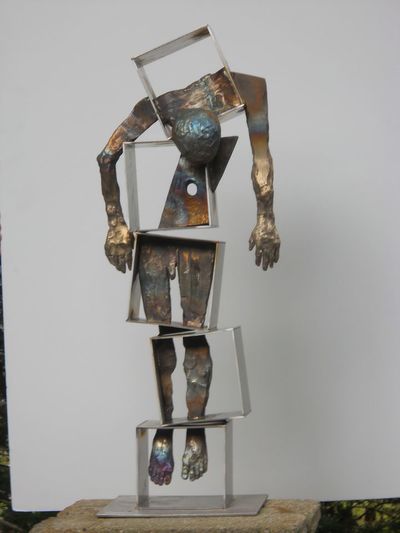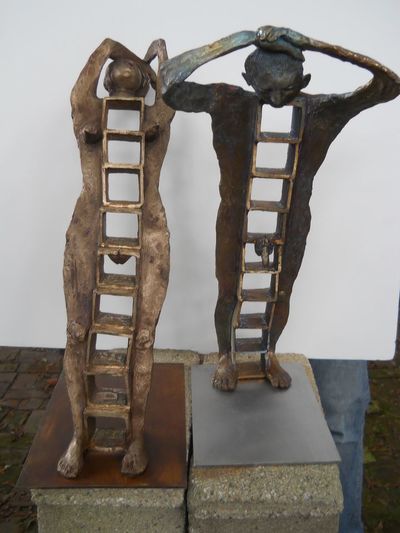Flatmansquared, new stainless steel and bronze sculpture by Ernesto Montenegro
Flatmansquared, new stainless steel and bronze sculpture
Ernesto Montenegro
May 3–May 31, 2014
R. Michelson Galleries
Northampton, MA
www.rmichelson.com
When first seen Ernesto Montenegro’s new sculptures suggest cruel contraptions that contain disassembled but living humans. His arrangements of sectioned bodies in stainless steel boxes at once reveal and remove their subjects. Some of the open boxes contain voids of body sections as though figures are equally present and disappearing.
A ‘figure in repose’ (Montenegro does not title his pieces), seems at ease in a somewhat angular way, but it is an ease suggestive of vital reduction—a slightly living figure, existing between life and after-life. An arm rests on the top of a box that contains the chest adjacent to the arm of a ‘normal’ figure. Bent at the elbow, it angles down to the floor, three finger tips poised there in a gesture of ‘connection’—perhaps an expression of longing for presence in the world. By segmenting the figure and containing the segments in tilted boxes, Montenegro introduces a geometric formal language that serves to parse the figure’s behavior, recalling the analytic drawings that overlaid paintings illustrated in art history books.
One could call the boxes cubes and create still another art historical association, but that would not effectively explain what Montenegro’s work addresses. The boxes are elements (note their plurality) that maintain the sense of stopping time that sculpture has traditionally been wedded to. Consider the arching body of the Discobolus of Myron (480-450BCE), poised in its famous muscular curve before the athlete throws his discus. This tension between of the static and the dynamic has been a feature of sculptural objects so long that the idea of ‘movement’ points to actual behavior and to our internal sense of that behavior when no actual movement exists.
A ‘swimmer’ is presented as a nearly complete figure, passing through three boxes—the boxes functioning here as segmented ‘water’ volumes. The appearance of motion feels credible even in this ‘stuck’ context. Vitality is asserted as an optimistic act of accomplishing.
Montenegro’s boxes provide an opportunity for the artist to undermine representational figuration’s narrative conventions. His working methods do not manifest an insistence on orderly and controlled results. Although working from clay to bronze has its condition of development in stages, these sculptures are inflected with a spontaneity of feelings that one sees more typically in painting.
In a way, the sculptures are somewhere between sculpture and painting—existing as though in 2.5 dimensions. Because the boxes frame, they also conceal, and sometimes eliminate forms; an ‘in the round’ experience is not quite available. What is available is a direction for thinking through the material identity of behaving bodies. Whether these bodies are persons whose actions are expressive of their personhood is not easily answered, but it is established within the artist’s figural specifics. The swimmer’s hands and feet have individuality, specific identity, sentiment.
A male and female pair of figures wear their boxes internally, as large, hollow spines that extend ladder-like through their torsos and between their legs. The hollowness is interrupted midway in the boxes that contain the genital centers of the figures. The faces are incomplete because the boxes begin their descent through the figures just below the noses. Their arms are set to rest upon their heads, as though their capacity to act has been arrested. They feel both vulnerable in space but invincible in their timelessness.
Montenegro’s work is in a gritty meditation on the function of art as a mediation between what is felt and what is arranged. Art, even the most emotionally driven, establishes and structures visibility. This structuring in figurative imaging
can trigger conditions of recognition of who and what human beings are.
— David Raymond



